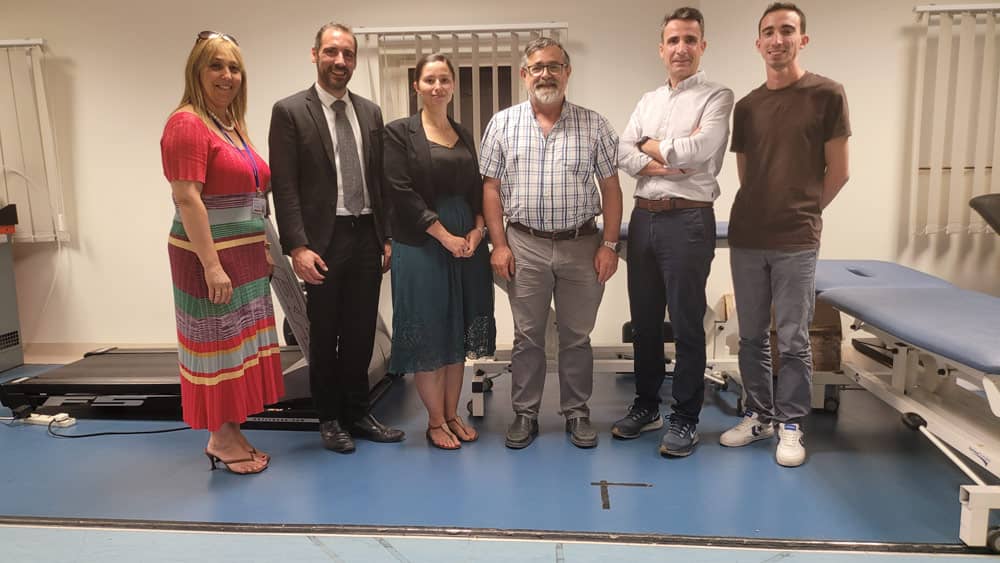In Malta, around 10% of the local population is affected by diabetes. This is especially alarming considering that diabetes can affect the blood and nervous system and eventually even lead to foot amputations. Researchers from the University of Malta (UM) and Mater Dei Hospital are trying to address this problem in their project Sit_Diab: Smart Insole Technology for the Diabetic Foot. They developed a novel method of detecting foot complications early enough to take action in time to help save limbs.
To prevent the amputation numbers from increasing, a research team from the University of Malta and the Mater Dei hospital, led by Professor Alfred Gatt, Associate Professor with the Faculty of Health Science, UM, developed a novel technology for early problem detection. This method will enable clinicians to take action in time to avoid amputations. ‘Having a part or your whole limb amputated leaves many repercussions on the patient and their quality of life. It also affects the health system, as these people would require many hospital appointments,’ Gatt said.
Prof Cynthia Formosa, Associate Professor with the Faculty of Health Science, explains how, ‘every 20 seconds a limb is lost in the world. However, around 80% of ulcerations can actually be prevented.’ It is this that led researchers to try and find a more innovative solution.
The Diabetic Foot
Diabetes has serious consequences that follow from unstable blood sugar levels. ‘Glucose is a sugar molecule that is a normal part of human blood,’ explains Prof. Gatt. ‘But if the amount of sugar rises too high, it damages the nervous system as well as the blood vessels.’ Areas of the body that are further away from the heart, most of all the feet, are particularly affected by these changes. People with high blood sugar levels run the risk of developing a condition called the diabetic foot.
A high glucose level causes the blood vessels to constrict. If the vessels get narrower, the blood-flow is obstructed and the parts of the body that are further away from the pumping heart suffer from an undersupply of blood. Such blood-shortages affect the feet in particular, since they are the most remote parts of the body.
The health of the cells is seriously affected by a low blood-supply. ‘If the blood flow is reduced, the blood can’t provide the cells with sufficient nutrients and oxygen, nor can it carry the cell’s waste material away properly,’ says Gatt. ‘Body parts with unhealthy cells are susceptible to injuries and once injured, healing could be compromised.’ The skin becomes so thin that even the slightest pressure from an uncomfortable shoe could be enough to injure the foot.
The effect high blood sugar levels have on the nervous system makes diabetes even more dangerous to the patients. The damage to the sensory nerves reduces the sensitivity to small injuries or other irregularities. People who’s sensory nerves are damaged can’t feel if excessive pressure is put on the foot or if a person steps on a sharp object. For a healthy foot, a small shard of glass is not a big deal. It is detected immediately and can be removed when the wound is still small. In a diabetic foot however, the wound can go undetected. The cells are lacking the blood supply to properly repair the injured skin which increases the risk of infection. The wound becomes inflamed causing a rise in temperature and, without treatment, this will develop into a diabetic ulcer which, in turn, if left untreated can eventually lead to bone infection. If prompt treatment is not given this could lead to amputation since severe ulcerations can cause serious infections affecting the bone and other adjacent tissues.
Traditional Treatments
There are different treatments to prevent amputations. Prof. Gatt points out that ‘the first and best method is to keep blood sugar levels as normal as possible to prevent diabetic foot complications from developing in the first place. With a normal amount of glucose in the blood, the nervous system as well as the blood vessels, keep their usual functionality and the feet of people with diabetes are not endangered.’ In cases where blood glucose is not regulated and complications arise, there are other ways to treat a diabetic foot.
Getting feet checked by a clinician, such as a podiatrist, who screens the foot for diabetes complications is essential for those patients with a high risk of developing a diabetic complications. Even small injuries need to be treated in a timely manner. Valuable as these consultations are, they are reactive rather than proactive. To determine which areas of the foot are at risk of injuries, it is important to keep track of foot plantar pressure areas, such as the balls of the feet and toes. These tend to have higher pressure than other areas of the foot and are thus more susceptible to developing wounds amongst other problems.
Clinicians address high pressure with a technique called offloading. Special insoles, designed to offload the pressure from the affected areas, are used to prevent complications. To be able to offload a foot, the areas that need offloading must be identified as early as possible. Ideally, regions that are under enough pressure to cause a wound would be offloaded before further complications develop. The problem is that traditional ways of measuring the pressure are very costly and therefore not conducted often enough to keep track of every change. Often, offloading is only initialised when there is a visible wound and not as a means to prevent complications. The Sit_Diab project aims to fill this gap by using specialised smart insoles.

The Smart Insole Technology
In their project, Prof. Gatt and his colleagues developed an insole that will help the early detection of complications. ‘The insole measures both pressure and temperature throughout the sole of the foot. Both of these measures are correlated with pre-stages of a diabetic ulceration. That means that the insole can tell us where an ulcer is about to develop,’ explains Prof. Gatt. The collected data is analysed utilising artificial intelligence that draws a detailed picture of the changes in the foot. The patients can use a smartphone app to keep track of what is going on in their soles and clinicians can use the data as an early warning system and to keep record of their patients. If high areas of pressure are detected while walking, the smart insole technology gives a warning so the foot can be offloaded to avoid complications.
If a wound could not be prevented, the smart insole technology can be used to monitor the course of the injury. A rise in temperature that could denote inflammation, can be detected by the insole as soon as it develops. The earlier the inflammation is treated, the higher the chances of preventing ulceration. This way, the novel technology can prevent further diabetic foot complications from developing. Prof.Gatt hopes that this ‘smart technology’ will aid to reduce diabetic foot complications and amputations. ‘It is unrealistic to think we could make all amputations redundant,’ he explains ‘but this use of preemptive medicine could avoid up to 80% of the ulcerations. Implemented on a national level that would mean that 400 limbs a year could be saved.’
Further research will be needed before the insole can be manufactured on a large scale, but the smart insole technology already is a big advancement in the treatment of the negative effects of diabetes. Keeping track of temperature and pressure readings in the foot, both of which are pre-stages to a diabetic foot ulceration, the new insole will hopefully aid in reducing complications and thus improves patients’ quality of life.
The Smart Insole Technology for the management of the Diabetic Foot (Sit_Diab) project is led by Professor Alfred Gatt, who together with Professor Cynthia Formosa, Dr Ing Marvin Bugeja and Dr Clifford DeRaffaele – and a team of other podiatrists and engineers – are striving to optimise this technology and make it available for use as soon as possible.
The Sit_Diab project is a 3-year project funded by the Malta Council for Science and Technology (MCST) through the Fusion R&I Technology Development Programme.
Further readings:
Gatt A, Falzon O, Cassar K, Ellul C, Camilleri K, Gauci J, Mizzi S, Mizzi A, Sturgeon C, Camilleri L, Chockalingam N, Formosa C. (2018). Establishing differences in thermographic patterns between the various complications in diabetic foot disease. International Journal of Endocrinology. Volume 2018, Article ID 9808295, 7 pages https://doi.org/10.1155/2018/9808295
Gatt A, Falzon O, Cassar K, Ellul C, Camilleri K, Gauci J, Mizzi S, Mizzi A, Sturgeon C, Camilleri L, Chockalingam N, Formosa C. (2018). The identification of higher forefoot temperatures associated with peripheral arterial disease in type 2 diabetes mellitus as detected by thermography. Primary Care Diabetes. 12(4): 312-318. doi: 10.1016/j.pcd.2018.01.001
Saliba Thorne C., Gatt A., DeRaffaele C., Bazena A., Formosa C. (2022). Innovative single-sensor, in-shoe pressure and temperature monitoring device: A dynamic laboratory validation study. Gait and Posture https://doi.org/10.1016/j.gaitpost.2022.11.013
Saliba Thorne C., Gatt A., Formosa C. (2021). Digital foot health technology and diabetic foot monitoring: A systematic review. Diabetes Research and Clinical Practice; Vol 175 DOI: https://doi.org/10.1016/j.diabres.2021.108783
Population reference bureau 2016 world population data sheet – PRB. www.worldpopdata.org. (2016). Retrieved January 9, 2023, from https://prb.org/wp-content/uploads/2016/08/prb-wpds2016.pdf
Sammut, R. (2021). Addressing the Malta National Strategy for Diabetes 2016-2020 research priority areas: A scoping review. Endocrine and Metabolic Science, 2, 100079. doi:10.1016/j.endmts.2021.100079





Comments are closed for this article!